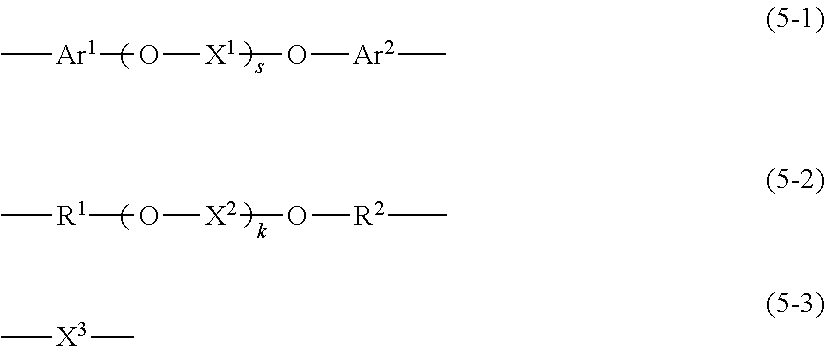Polylactic acid composition
a technology of polylactic acid and composition, applied in the field of reinsin composition, can solve the problems of inability to proceed with the use of terephthalate and polyethylene terephthalate, and achieve the effect of excellent hydrolysis resistance and heat stability, and low environmental burden
- Summary
- Abstract
- Description
- Claims
- Application Information
AI Technical Summary
Benefits of technology
Problems solved by technology
Method used
Image
Examples
production example 1-1 (
A-α-1: poly-L-lactic Acid (PLLA))
[0439]0.005 part by weight of tin octylate was added to 100 parts by weight of L-lactide (manufactured by Musashino Chemical Laboratory, Ltd., optical purity of 100%) to carry out a reaction in a reactor equipped with a stirring blade in a nitrogen atmosphere at 180° C. for 2 hours, phosphoric acid was added in an amount 1.2 times the equivalent of tin octylate, the remaining lactide was removed at 13.3 Pa, and the obtained product was cut into a chip to obtain poly-L-lactic acid.
[0440]The obtained poly-L-lactic acid had a weight average molecular weight of 152,000, a melting enthalpy (ΔHmh) of 49 J / g, a melting point (Tmh) of 175° C., a glass transition point (Tg) of 55° C. and a carboxyl group content of 14 eq / ton.
production example 1-2 (
A-α-2: poly-D-lactic Acid (PDLA))
[0441]The operation of Production Example 1-1 was repeated except that D-lactide (manufactured by Musashino Chemical Laboratory, Ltd., optical purity of 100%) was used in place of L-lactide of Production Example 1-1 to obtain poly-D-lactic acid. The obtained poly-D-lactic acid had a weight average molecular weight of 151,000, a melting enthalpy (ΔHmh) of 48 J / g, a melting point (Tmh) of 175° C., a glass transition point (Tg) of 55° C. and a carboxyl group content of 15 eq / ton.
production example 1-3 (
A-α-3: Stereocomplex Polylactic Acid (scPLA))
[0442]100 parts by weight of polylactic acids consisting of 50 parts by weight of PLLA and 50 parts by weight of PDLA obtained in Production Examples 1-1 and 1-2 and 0.1 part by weight of phosphoric acid-2,2′-methylenebis(4,6-di-tert-butylphenyl)sodium (Adecastab NA-11: ADEKA Corporation) were mixed together by means of a blender, and the resulting mixture was dried at 110° C. for 5 hours and supplied into the TEX30XSST 30 mmφ vented double-screw extruder of The Japan Steel Works, Ltd. to be melt extruded into a pellet at a cylinder temperature of 250° C., a screw revolution of 250 rpm, a discharge rate of 9 kg / h and a vent vacuum degree of 3 kPA so as to obtain polylactic acid 1. The obtained stereocomplex polylactic acid had a weight average molecular weight of 130,000, a melting enthalpy (nHms) of 56 J / g, a melting point (Tms) of 220° C., a glass transition point (Tg) of 58° C., a carboxyl group content of 17 eq / ton and a stereocomplex...
PUM
| Property | Measurement | Unit |
|---|---|---|
| wt % | aaaaa | aaaaa |
| wt % | aaaaa | aaaaa |
| mol % | aaaaa | aaaaa |
Abstract
Description
Claims
Application Information
 Login to View More
Login to View More - R&D
- Intellectual Property
- Life Sciences
- Materials
- Tech Scout
- Unparalleled Data Quality
- Higher Quality Content
- 60% Fewer Hallucinations
Browse by: Latest US Patents, China's latest patents, Technical Efficacy Thesaurus, Application Domain, Technology Topic, Popular Technical Reports.
© 2025 PatSnap. All rights reserved.Legal|Privacy policy|Modern Slavery Act Transparency Statement|Sitemap|About US| Contact US: help@patsnap.com



